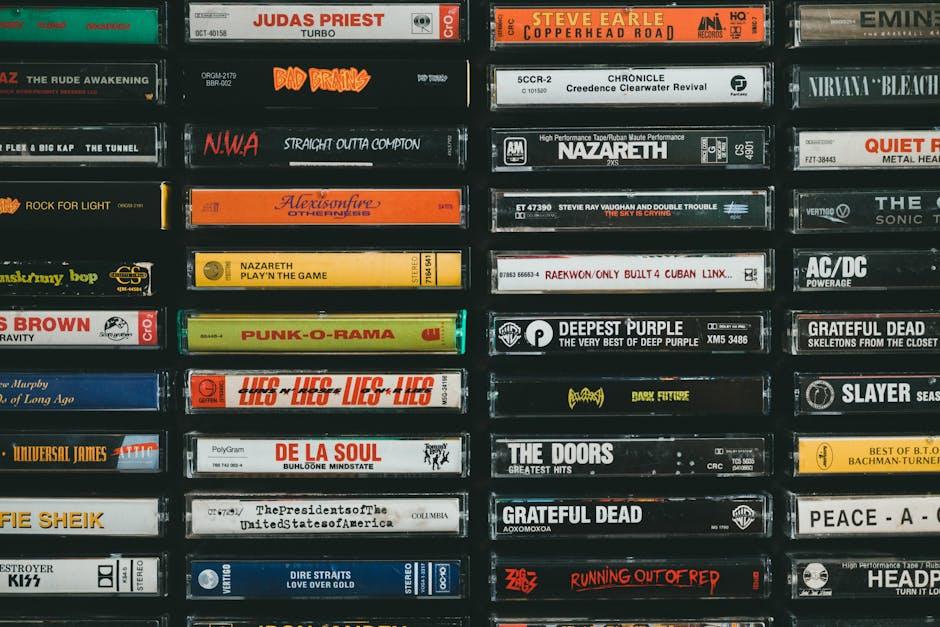In a world brimming with endless melodies and rhythms, crafting the perfect playlist has become both an art and a science. Whether you’re setting the mood for a lazy Sunday, fueling an intense workout, or curating the soundtrack for a road trip, the way you arrange songs can transform any moment into an experience. But what makes a playlist truly captivating? Beyond just stringing together favorite tracks, there’s a thoughtful process that balances flow, theme, and discovery. In this article, we’ll explore practical tips and creative strategies to help you master the craft of playlist creation, turning your personal selections into seamless journeys of sound.
Table of Contents
- Crafting the Mood: Setting the Emotional Tone for Your Playlist
- Balancing Variety and Cohesion: Selecting Tracks That Flow Seamlessly
- Understanding Your Audience: Tailoring Song Choices to Listener Preferences
- Mastering Transitions: Techniques for Smooth Song Changes
- Leveraging Themes and Narratives to Enhance Listener Engagement
- Curating for Different Occasions: Designing Playlists for Specific Settings
- Q&A
- Key Takeaways

Crafting the Mood: Setting the Emotional Tone for Your Playlist
When curating a playlist, the emotional undercurrent acts as the invisible thread weaving every song into a cohesive tapestry. Start by identifying the core feeling you want your playlist to evoke—whether it’s the nostalgia of a sunlit afternoon, the adrenaline rush of a workout, or the calm comfort of a rainy evening. Focus on tracks with melodies, rhythms, and lyrics that complement your chosen vibe. Consider using softer harmonies and slower tempos for reflective moments, or high-energy beats and vibrant sounds to ignite excitement. Integrating diverse genres that align with the same emotional spectrum can also add depth and keep the listening experience engaging.
To organize your tracks effectively, try grouping songs by intensity or sentiment to create a natural flow. Here’s a handy reference to balance moods within a playlist:
| Emotion | Musical Elements | Example Artists |
|---|---|---|
| Chill & Relaxed | Soft beats, mellow vocals | Norah Jones, Bon Iver |
| Energetic & Uplifting | Fast tempo, bright melodies | Dua Lipa, Calvin Harris |
| Melancholic & Reflective | Minor keys, thoughtful lyrics | Adele, The National |
| Joyful & Fun | Major keys, catchy hooks | Pharrell Williams, Bruno Mars |
- Anchor your playlist with standout songs that perfectly capture the mood.
- Blend familiar and new tracks to offer comfort alongside surprise.
- Allow space for emotion to breathe with instrumental or interlude tracks.

Balancing Variety and Cohesion: Selecting Tracks That Flow Seamlessly
Creating a captivating playlist requires a keen ear for tracks that not only sparkle individually but also complement each other. This delicate dance between variety and cohesion ensures the listener experiences a journey rather than scattered musical moments. One useful approach is to weave in songs from different genres or tempos that share a common mood, key, or lyrical theme. This allows each track to bring something new to the table while maintaining a thread that ties the entire collection together.
To help keep your playlist balanced and smooth, consider the following strategies:
- Gradual transitions: Move slowly from upbeat to mellow tunes to avoid abrupt shifts.
- Storytelling flow: Arrange songs as if telling a story — with an introduction, climax, and resolution.
- Consistent energy levels: Mix high-energy tracks with laid-back numbers to create breathing room.
- Thematic links: Connect songs with similar themes, whether lyrical or instrumental.
| Element | Example | Effect |
|---|---|---|
| Key | C Major to A minor | Smooth harmonic transition |
| Tempo | 90 BPM to 100 BPM | Natural buildup in rhythm |
| Theme | Love and heartbreak | Emotional continuity |

Understanding Your Audience: Tailoring Song Choices to Listener Preferences
Creating the perfect playlist starts with a deep connection to the people it’s meant for. By tuning into the moods, tastes, and even the time of day your listeners favor, you can craft a musical journey that resonates on a personal level. Consider the genres they gravitate towards, but don’t shy away from adding a few unexpected tracks that could spark new favorites. Tailoring your selections with these preferences in mind ensures the playlist is not only heard but genuinely enjoyed, making every song feel like it was chosen just for them.
To make this process easier, keep an ongoing list of your audience’s reactions and feedback. You might find patterns emerging, such as a preference for upbeat songs during the morning or mellow melodies late at night. Here’s a simple way to organize these insights:
| Listener Segment | Preferred Time | Favored Genres | Key Mood |
|---|---|---|---|
| Young Adults | Evenings | Indie, Pop | Energetic, Chill |
| Office Workers | Daytime | Jazz, Soft Rock | Focused, Calm |
| Fitness Enthusiasts | Morning, Afternoons | EDM, Hip-Hop | Motivated, Upbeat |
By returning regularly to these notes, you keep your playlist dynamic and fresh, always aligned with what your listeners crave.

Mastering Transitions: Techniques for Smooth Song Changes
Seamlessly bridging one track to the next is an art form that can elevate any playlist from ordinary to extraordinary. Start by emphasizing key matching, where songs share compatible musical keys, ensuring a natural and pleasant harmonic flow. Another impactful technique involves aligning the tempo of consecutive songs—gradually increasing or decreasing BPM to gently guide the listener through the shift without a jarring disruption. Layering tracks with similar energy levels or moods further guarantees a fluid listening journey, allowing each transition to feel intentional rather than abrupt.
Employing creative fades and overlaps can also masterfully mask the changeover between songs. For example, use crossfading to blend the outro of one track with the intro of the next, creating a smooth sonic handshake. Also, consider employing bridging tracks—short instrumentals or interludes that act as auditory buffers. Below is a simple reference table outlining common transition techniques and their effects on the flow:
| Technique | Effect |
|---|---|
| Key Matching | Maintains harmonic harmony |
| BPM Alignment | Smooth tempo shifts |
| Crossfading | Seamless overlapping of tracks |
| Bridging Tracks | Creates natural auditory pauses |

Leveraging Themes and Narratives to Enhance Listener Engagement
Crafting a playlist that captivates listeners involves more than just stringing together popular tracks; it’s about weaving a story that resonates. By focusing on a central theme—whether it’s an emotion, a journey, or a specific moment—you create a cohesive flow that keeps listeners hooked. Consider building your playlists around narratives like “midnight city drives” or “summer nostalgia,” which provide context and invite listeners to immerse themselves fully. Strategic song placement enhances this effect, ensuring smooth transitions that mirror the story’s rhythm and intensity.
To amplify engagement, integrate diverse yet complementary genres and artists that align with your theme. Below is a simple table showcasing theme ideas alongside possible narrative directions and sample genres:
| Theme | Narrative Direction | Sample Genres |
|---|---|---|
| Urban Nightlife | Energy building from dusk to dawn | Electronic, Hip-Hop, Indie Pop |
| Morning Serenity | Calm awakening and peaceful moments | Acoustic, Chillwave, Soft Jazz |
| Road Trip | Adventure and spontaneous stops | Rock, Country, Alternative |
- Maintain a clear emotional trajectory by aligning songs to the highs and lows of your narrative.
- Use lyrical themes to deepen connection, allowing listeners to relate on a personal level.
- Mix familiar hits with hidden gems to keep the playlist fresh yet comforting.

Curating for Different Occasions: Designing Playlists for Specific Settings
When curating music tailored to specific settings, it’s essential to consider the atmosphere you want to create. Each occasion carries its own vibe—whether it’s the energetic buzz of a workout session or the cozy ambiance of a dinner party. Crafting playlists with this in mind ensures that every track plays its part in enhancing the experience. Focus on mood, tempo, and genre variety to keep the listener engaged without disrupting the intended environment. For example, a brunch playlist might blend upbeat indie tunes with smooth jazz, while a work-focused list favors instrumental and low-beat tracks to support concentration.
To streamline the creation process, organizing your playlist elements in a simple structure can be a game-changer. Here’s a quick guide on how to balance key playlist components for different events:
| Occasion | Energy Level | Genre Ideas | Playlist Length |
|---|---|---|---|
| Workout | High | Electronic, Hip-hop | 30-45 mins |
| Dinner Party | Moderate | Jazz, Soft Rock | 1-2 hours |
| Study | Low | Classical, Ambient | 1-3 hours |
- Adjust volume and transitions to suit the space and activity.
- Include familiar hits for instant connection with the audience.
- Test your playlist beforehand to ensure smooth flow and balance.
Q&A
Q: What’s the first step in creating a great playlist?
A: Start with a clear theme or mood in mind. Whether it’s for a workout, a chill evening, or a road trip, having a focus helps guide your song choices and keeps the playlist cohesive.
Q: How important is song order in a playlist?
A: Very! Think of your playlist like a story with a beginning, middle, and end. Vary the tempo and energy to keep listeners engaged—start strong, build momentum, then wind down gracefully.
Q: Should I only include my favorite songs?
A: Not necessarily. While personal favorites add authenticity, mixing in lesser-known tracks or fresh finds can surprise and delight your audience. It keeps the playlist dynamic and diverse.
Q: How many songs should a playlist have?
A: There’s no one-size-fits-all answer, but aim for enough to sustain the vibe without overwhelming—usually 20 to 40 tracks. This length works well for most listening sessions.
Q: Can playlists be updated over time?
A: Absolutely! A living playlist reflects your evolving taste or changing moods. Don’t hesitate to swap songs in or out; it keeps your playlist fresh and relevant.
Q: What tools help with playlist creation?
A: Streaming platforms like Spotify and Apple Music offer playlist-building tools and suggestions based on your listening habits. Additionally, apps like Soundiiz help transfer playlists between services seamlessly.
Q: How do I avoid copyright issues if I want to share my playlist publicly?
A: Sharing playlists through authorized streaming platforms is generally safe because they handle licensing. If you’re creating mixes or using tracks outside these platforms, ensure you have proper permissions.
Q: Can playlists influence how people perceive me?
A: Definitely! Your playlist can be a reflection of your personality, taste, and creativity. Sharing thoughtfully curated playlists is a subtle way to express yourself without saying a word.
Q: What’s one tip for keeping listeners hooked?
A: Add surprise elements—unexpected genre shifts, rare tracks, or exclusive live versions. These moments create excitement and keep listeners coming back for more.
Q: How do I make a playlist accessible to others?
A: Use platforms that allow sharing links or collaborative playlists. Write a brief description to set expectations and invite feedback or contributions to foster a sense of community.
Key Takeaways
Crafting the perfect playlist is both an art and a science—a delicate balance of mood, flow, and personal touch. Whether you’re curating for a quiet evening, a high-energy workout, or simply to discover new sounds, these tips can help transform a simple list of songs into a memorable musical journey. So go ahead, experiment with genres, blend tempos, and follow your instincts. After all, the best playlists don’t just play music—they tell a story. Happy listening!

